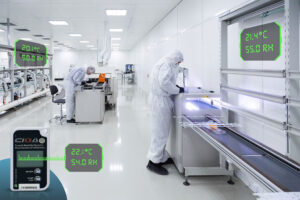| The component qualification is intended to confirm that raw materials and components manufactured by a third-party supplier and received by the client are within the correct quality attributes and design specification criteria.
Components could include packaging materials such as bottles, containers, caps, tips, folding cartons, shipping cases, labels or even phase change material, etc. All of these components must have some type of incoming inspection to ensure that the third-party manufacturer’s process is consistently producing components.
The QS/GMP requires manufacturers to evaluate their suppliers and to evaluate their quality data for problems. One method of doing this, similar to the requirements in the old GMP, is to record the percentage of “essential” component rejects per lot, as well as the percentage of lots rejected. If the manufacturer has the raw accept/reject data in a form that can be evaluated to determine supplier performance, and is periodically doing this evaluation, this would be acceptable in lieu of recorded percentages.
Scope, the CQ is applicable for:
• New component development
• Component design changes affecting a Supplier manufacturing process
• A Supplier process change which affects manufacturing processes used to make the component
• Transfer of component manufacturing processes
The Component Qualification Process is divided into four (4) steps:
―Step 1: Planning and Component Qualification Plan or Protocol preparation
―Step 2: Execution
―Step 3: Review and Disposition
―Step 4: Communication and Change Control Management
Step 1. Planning and plan/protocol preparation
The following actions will take place during this phase:
― Assessment of the extent of Component Qualification activities required
― Identification of deliverables
― Creation and approval of the plan or protocol CQ
Typical items considered during phase are as follows:
1. Product requirements
2. Manufacturing Materials/Process Aids
3. Process Flow Diagram
4. Process Risk Analysis
5. Measurement System Analysis (MSA)
6. Equipment Installation Qualification (IQ)
7. Process Characterization
8. First Article Inspection (FAI)
9. Process Operational Qualification (OQ)
10. Performance Qualification (PQ)
11. Process Capability Assessment
12. Process Control Plan
13. Process Work Instructions
The CQ protocol may include, but, is not limited to the following sections,
(as applicable)
• Purpose
• Scope
• Background
• Component Description
• Manufacturing Equipment Identification
• Associated Documents
• Definitions and Acronyms
• Process, Equipment Description, and Product Verification Instructions -Test Steps, as applicable.
– the studies or tests to use,
– the criteria appropriate to assess outcomes,
– the timing of qualification activities,
– the responsibilities of relevant departments and the quality unit, and
– the procedures for documenting and approving the qualification.
Evaluation of changes.
Definition of the component qualification criteria and test procedures.
Selection of critical process parameters, with predefined specifications.
Determination of the sampling plan and test intervals, e.g.,
(a) –Every day, every shift, etc.
(b) – Every time the starts the component manufacturing or the component is used, etc.
(c) – Before, between, and after a series of runs.
Define corrective actions on what to do if the component does not meet the established criteria.
That when the component contains large quantities of dimensions, data, queries etc.
That concurrent independent factors, dimensions parameters and work-flows do not affect each other
That a laboratory test correctly identifies a known material
That a process was completed within defined component requirements
Manufacturing conditions such as equipment limits, operating parameters and component inputs.
A thorough list of the data that should be recorded or analyzed during testing, calibration, and validation
Tests to ensure consistent quality throughout production.
A sampling plan detailing the sampling methods used during and in between production batches
Analysis methodology for making data, scientific and risk-oriented decisions based on statistical data, for example Ppk, Cpk, control charts, etc.
Definitions for variability limits and contingency plans for handling non-conformance
• Analysis of Test Results
• Acceptance Criteria
• Incident Reports Summary
• Conclusions and Recommendations
• Final Resolution and Release
• Associated Reference Documents
• Appendices
• History of Change
• Document Approval
Step 2: Execution
The Supplier shall execute their activities as documented in the Component Qualification Plan or protocol.
If a deviation from the plan is required, the Supplier will notify the client to assess the impact.
Deviations are to be reviewed prior to execution.
Step 3: Review and Disposition
The Supplier shall submit to the client company specified deliverables from the Component Qualification Plan or protocol.
• Suppliers must submit the raw data and statistical results of the component qualification protocol in a Qualification Summary Report content and format as specified by the client company.
• The QA client representatives will determine the appropriate approval functions in conjunction with the supplier QA team.
Step 4: Communication and Change Control Management
The client will notify the Supplier regarding the approval and implementation strategy after completed the component qualification plan or protocol, as applicable.
The supplier must notify the client of any change or modification that may arise over time in the process, equipment, parameter or materials used in the manufacturing of the client’s components to evaluate them using the applicable change control management procedure.
In a similar manner, the client must notify the supplier of any change or modification that may arise over time in the tolerance parameter or specifications necessary for their components and evaluate them using the applicable change control management procedure.
Based on the type of change, determine the necessity to requalify the original component qualification.
What makes CQ successful?
Successful CQ must demonstrate that the process, equipment, and raw materials do as established in the Component Design Specifications Document.
Component qualification (CQ) execution can initiate after completed the execution and approval of the Installation Qualification and Operational Qualification activities.
The component qualification must be executed by experienced and trained operators or engineers as the component quality attributes are being tested and released.
Component Qualification protocol(s) should be approved before protocol execution to comply with the prospective validation approach.
A copy of the unexecuted protocol should be kept in the validation package.
The unexecuted protocol should be approved at least by the protocol author, supplier QA representative, and client QA representative.
The final report of the executed protocol should be signed at least by the tester, reviewed by the supplier QA representative and client QA representative.
Important items to consider during the Component Qualification activities:
Below is a list of issues that are essential to address during a part of a purchased assembly qualification.
1. Check if there a less expensive alternative part that would save the company some money.
2. Verify if the component was previously disqualified from the Item Master.
3. Check if the purchasing department previously disqualified the supplier from the AML (Approved Manufacturer’s List) or AVL (Approved Vendors List). Be aware of the manufacturer(s) disallowed for business reasons, costs or because they failed a supplier quality audit.
4. Verify the operating environment of the component including the manufacturing and storage conditions of temperature, % relative humidity, light, viable and non-viable contamination, cleaning, appearance, color, vibration, and other stress related conditions, as applicable.
5. Make sure that exist a complete design specification document approved from the component owner, from which to develop the component qualification plan or protocol.
6. Make sure the component part already exists in the Item Master, either another class-code, part number, or description.
If the component part number exists, verify its history of discrepancies, out of tolerance, SCARS – complaints, and any other problem, including previous component qualifications.
7. Make sure that if the part is already in the Item Master, is it on the Preferred Parts List (PPL).
8. Verify if the component comes from a sole or single source. If so, then you must consider to identify and qualify a second or alternate source. This is not always possible. In that event, Purchasing should be notified as early as possible to allow them to check their sources for lead-times and costs.
9. Evaluate if the component is an early engineering sample with design specifications marked as “Preliminary” and not yet in volume production.
Preliminary design specifications (datasheets) are a heads-up with a high error tolerance. Therefore, those specifications may change over time before be the final design specifications. Preliminary design specifications are not 100% reliable for the final volume production of components.
10. Coordinate with the Manufacturer’s Representative or Salesperson to bring enough samples to allow for a sufficient sample quantity for the component qualification testing.
11. Check if the supplier and the client company have the appropriate equipment, training, and expertise to test the quality attribute(s) and component specifications in-house or do it need to be tested at an outside facility. |
















